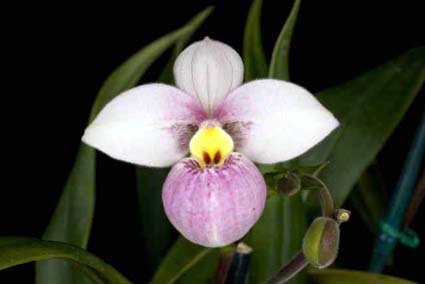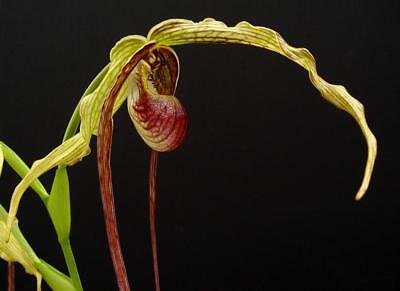Phragmipedium Orchid Care: The Basics
Phragmipedium orchid (frag-mi-PEE-dee-um) is often referred to as Slipper Orchids, and are closely related to the “Lady Slipper Orchid” which is the Paphiopedilum orchid. The Phragmipedium is a small genre and only has approximately 25 species.
Phragmipedium’s foliage is leathery, strap-like, and grows in a fan-shaped pattern. Some of these orchids can produce leaves that reach two feet in length.
Phragmipediums produce new growth from the base of each stem. Each growth produces a terminal spike with two to eight blooms that open consecutively.
Phragmipediums flower in the spring, and because the blooms open in succession, your orchids flower display can last for months at a time!
A Phrag’s flowers have lateral sepals that are fused together to form a synsepal, along with the pouch-shaped lip that protrudes. Phragmipedium blooms look similar to the Paphiopedilum orchid although there are a few distinctive differences such as the inward-curved lip edge on the Phrag.
The blooms have a few bristles near the column to help slide pollinators down into the lip pouch. Once the pollinators go down into the pouch, the only exit is through the opening in the back, which in turn, pollinates the flowers.
The flowers come in an assortment of colors. Many are bright red or orange although others are yellow, green, or brown with maroon or purple striping, or white with light purple or pink streaks.
If you want to try your hand at growing a Phragmipedium orchid, you will need to ensure that you have enough space because they can become large fairly quickly.
Water Requirements
Watering frequency – as covered in this article about watering orchids – can be determined by a few different things. Phragmipedium orchids should be watered very frequently.
During the warm months, you may have to water your Phrag every day and you can reduce waterings during the winter to two or three times a week.
You want to make sure to not let your Phragmipedium orchid dry out completely but at the same time be sure not to let the orchid become soggy either. You will want to ensure that you are allowing the orchid to drain very well.
Light Requirements
As covered in this article about orchids care and light, Phragmipediums need medium light intensity in order to thrive.
The best place to grow your Phragmipedium orchid indoors is on a western facing windowsill or within a foot of a southern facing windowsill.
Be sure to avoid letting your Phrag get direct sunlight during the summer because the intense sun could cause sunburn on the foliage.
Temperature Requirements
As discussed in this orchid plant care article on temperature, the temperature requirements for Phragmipedium orchids are in the intermediate range.
The ideal daytime temperatures to grow your Phragmipedium orchid is between 70°F to 80°F (21.1°C to 26.7°C), and night temperatures are between 55°F and 65°F (12.8°C to 18.3°C).
Certain species (such as those found at lower elevations) can handle temperatures on the higher end of these daytime and nighttime ranges.
Humidity Requirements
As covered in this “humidity” article on how to care for orchids, Phragmipedium orchids do best with a humidity level between 50-70 percent.
You can easily measure the amount of humidity in your orchids growing environment to determine if you need to increase the humidity.
If you need to increase the humidity level for your orchid you can do so by placing your orchid on a humidity tray or by placing a humidifier close by the orchid.
Phragmipedium orchids should not be misted to increase humidity because this can make the plant more susceptible to disease. Remember to maintain proper air movement by turning on an overhead fan or placing an oscillating fan nearby.
Fertilizer Requirements
Phragmipedium orchids should be fertilized with a diluted high-nitrogen solution (30-10-10) once every two weeks in the summer when the orchid is in active growth.
When the orchid is not in active growth, fertilizing once every three of four weeks with a balanced (20-20-20) solution is sufficient. Remember to only fertilize your orchid when the potting medium is damp.
Never fertilize a dry orchid because this can cause major root damage. It is important to flush out any excess fertilizer (once a month) so that the excess does not do damage to the plant’s roots or leaves.
Potting Requirements
A Phragmipedium orchid should be repotted once it is large enough to be divided. You should divide the plant with three growths per division and once blooming has ceased.
A medium-grade potting media that retains moisture and at the same time offers good drainage is recommended such as fir bark mixed with charcoal, perlite, sand, or sphagnum moss.
Rockwool mixed with perlite and charcoal is another good potting mix for Phrags, but keep in mind that rockwool can build up minerals so you will have to frequently flush out the excess minerals more often.
And that just about covers the basics! 🙂
Originally posted 2021-02-22 22:05:22.






